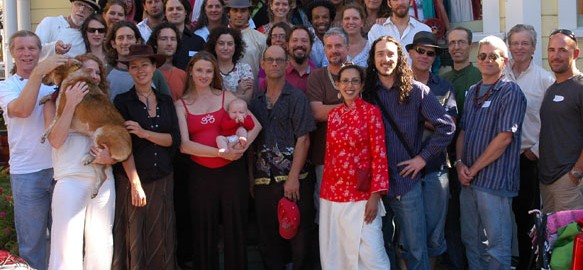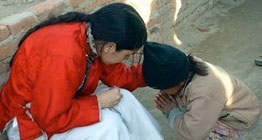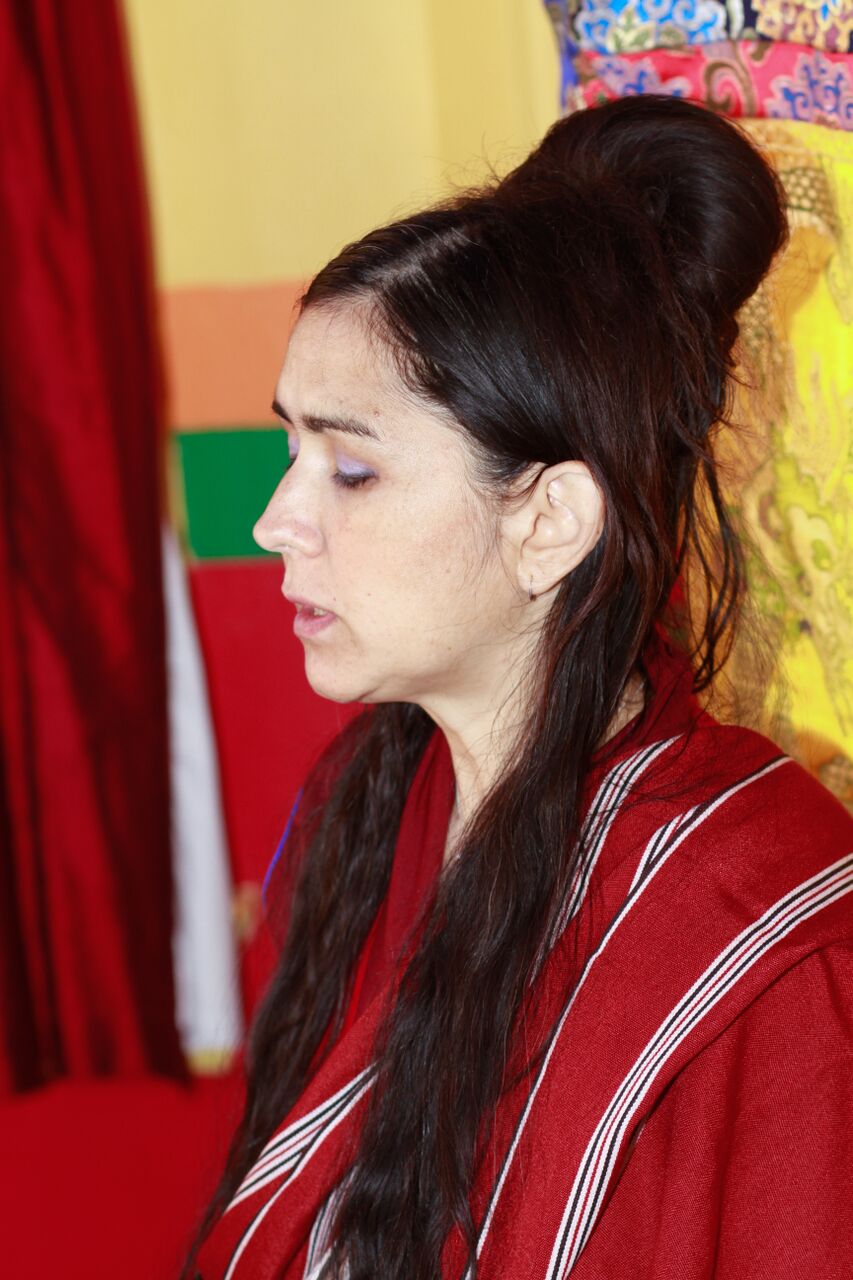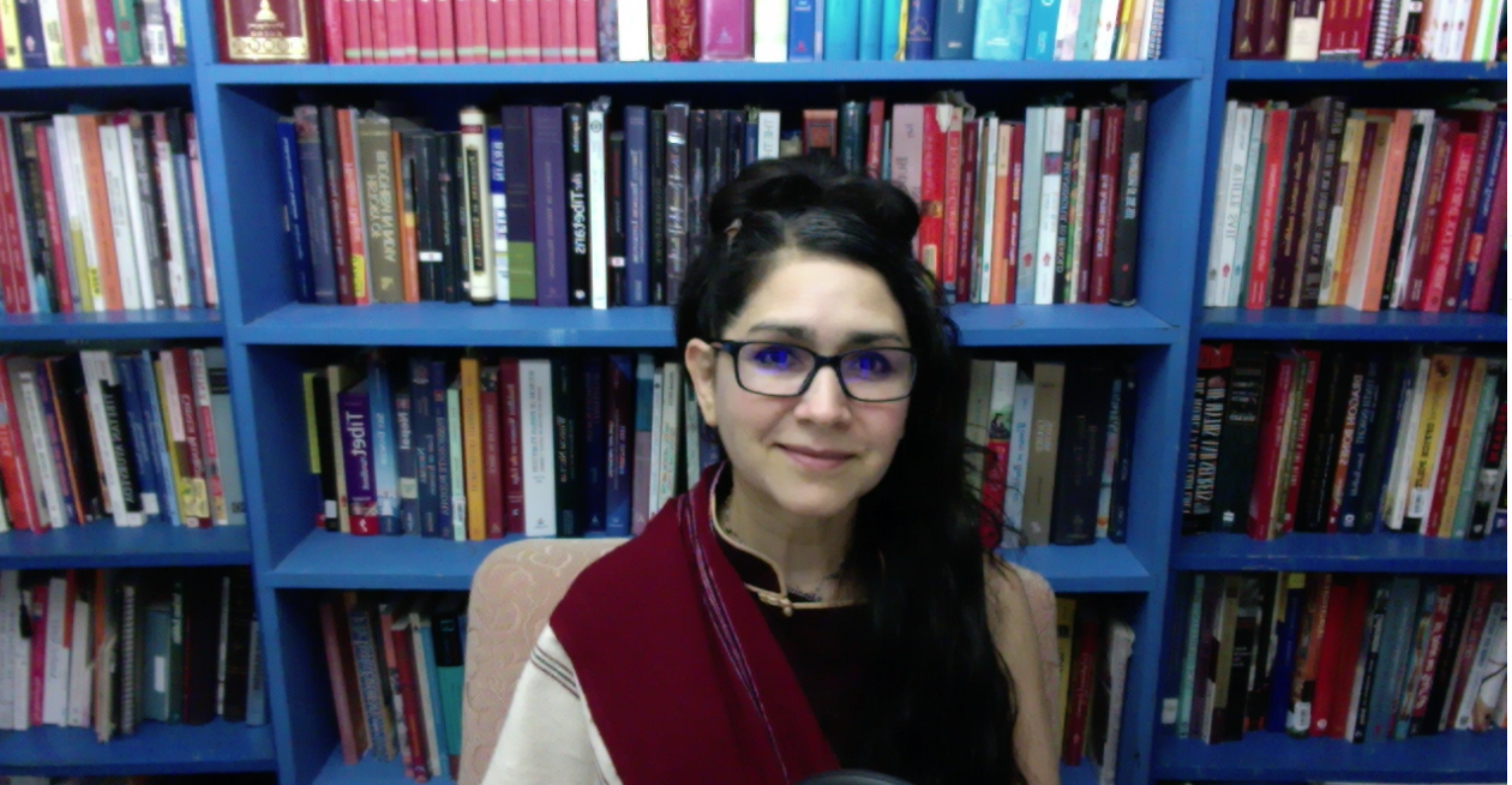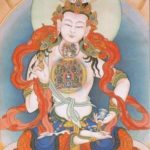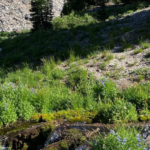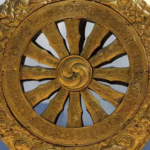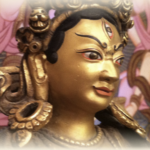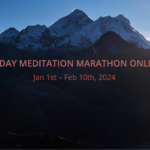Pema Khandro’s career as a Buddhist scholar and teacher emerged from a lifelong journey through eastern philosophy, Buddhism, Himalayan medicine and Yoga which led her throughout North America, Europe, India, Nepal and Tibet. This page includes Pema Khandro’s biography, the extended version. It covers five topics: the early years, study, practice, and enthronement, women in Buddhism, teaching activities, and academic interests. Read more about her recognition and enthronement here.
1. Early Years
Pema Khandro first learned Buddhist meditation when she was five and trained with her Buddhist teachers for a decade into her teens. She recalls learning meditation as a child while sitting with her teacher, who told her to count her thoughts. Her teachers taught her Buddhist principles in simple ways emphasizing that the goal of Buddhism was to find what is already here, but had not been noticed. She saw her teachers on an almost daily basis and this was the beginning of a life long journey into the study of Buddhism. After this, in her teens, she spent a few years exploring world religions and traveling around the world. She meditated in Himalayan caves, spun with Sufis, lit candles in ancient goddess temples, and absorbed herself in yoga. She discovered that she appreciated the beauty in each tradition but found her home in Buddhist philosophy and practice. She was most moved by the Buddhist view that every person has natural goodness in them. Compelled by the dynamic spectrum of practices in Buddhism, she immersed herself in Tibetan Buddhism’s intellectual and contemplative practices and eventually in scholarly research.
Health and natural medicine are a major interest of Pema Khandro, after surviving serious childhood illness. She developed a passion for vegan lifestyle and organic foods, although she advocates that there is not one right diet and lifestyle for everyone. After learning about cruelty to animals when she was a teenager, she became a vegetarian. She continues to be dedicated to a cruelty-free, sustainable lifestyle.
During her yoga years as a young girl, Pema Khandro trained in Hatha Yoga receiving certifications as an advanced yoga teacher in three different systems, became a yoga teacher and yoga therapist. This led to training yoga teachers and studying Tibetan Yoga. Tibetan Yoga practices are a regular feature of practice at Pema Khandro’s residential centers. Tibetan Yoga practices are also part of the retreats, courses and health trainings that she offers.
This interest in body-mind sciences also led her to learn Ayurveda and Tibetan Medicine, which she studied in India, North America and Europe. She studied Tibetan Medicine with Dr. Pasang, and also studied Tibetan Medicine and Ayurveda with Dr. Naram in India. Her interests in natural health continue to be weaved into her teaching and practice, and these interests only grew stronger after a decade of recovering from a lethal case of rocky mountain spotted fever, and Lyme disease.
2. Study, Practice, and Enthronement
Pema Khandro ordained in the Nyingma tradition and received authorization to pass the non-monastic lineage of Buddhist Yogis, Ngakpas and Naljorpas onto her students, a task which she has dedicated Ngakpa International to since 1999.
Pema Khandro received a recognition and enthronement by the head of the 900 year-old Druk Tashi Dhargey Chokor Dechenling Monastery in Tibet, His Eminence Gyaldak Rinpoche. She was recognized as the present reincarnation (tulku) of an early twentieth-century yogini. She was given the title Tulku Pema Khandro Rinpoche when she received the lineage of this yogini who practiced in the Nyingma and Kagyu lineages in Eastern Tibet. She continues the legacy of those teachings focusing on Dzogchen, Chod, and the Six Yogas. Gyaldak Rinpoche encouraged her to spread the esoteric teachings of Buddhism in North America and throughout the world.
Tulku Khandro has studied and done retreat with Lamas of the Nyingma, Kagyu, and Gelug traditions, but her focus has been on the Nyingma tradition. When studying full time with her Buddhist Lamas, her studies drew her to India, Nepal, Tibet, Europe, the US, Canada, and Mexico. Although she studied with numerous teachers during the journey that began when she was five, her most influential teachers have been Gangteng Tulku Rinpoche and Ngak’chang Rinpoche each of whom who have also taught her students during many visits to her home and her center. She regards her most important instruction as coming from a female 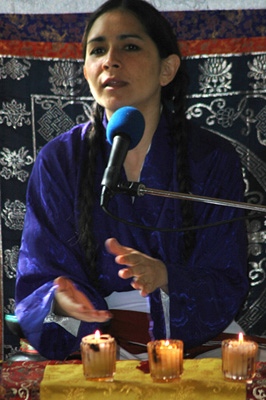 teacher Ani Dawa, (see below). She also received empowerments་and teachings from many other great teachers who impacted her and inspired her including Garchen Rinpoche, Drupon Rinchen Dorjee Rinpoche, Khenpo Yeshi, Khenpo Thubten Choying Rangdrol, Khenpo Tsultrim Lodro Rinpoche, Gangten Tulku Rinpoche, Trulshik Rinpoche, His Holiness Dalai Lama, Ngakpa Lama Munser Rinpoche, Dudjom Rinpoche, Khenpo Sodargye, His Eminence Gyaldak Rinpoche, Namkhai Norbu Rinpoche, Chodpa Kunzang Dorjee, Lama Chodak Rinpoche, Ani Dawa, Chokyi Nyima Rinpoche, Lama Wangdu Rinpoche, Sangngak Tulku Rinpoche, Lama Pema, Lama Tenzin Rinpoche, Tsewong Rinpoche, Lama Tharchin Rinpoche, Lopon Phurba Dorje, Nechung Kuten Rinpoche, Khenpo Karma Wangyal, Khenpo Gawang Rinpoche, Lama Lhanang Rinpoche, Aku Nyangchag Jal, Gazing Rinpoche, and Sherab Dorje Rinpoche, and many others.
teacher Ani Dawa, (see below). She also received empowerments་and teachings from many other great teachers who impacted her and inspired her including Garchen Rinpoche, Drupon Rinchen Dorjee Rinpoche, Khenpo Yeshi, Khenpo Thubten Choying Rangdrol, Khenpo Tsultrim Lodro Rinpoche, Gangten Tulku Rinpoche, Trulshik Rinpoche, His Holiness Dalai Lama, Ngakpa Lama Munser Rinpoche, Dudjom Rinpoche, Khenpo Sodargye, His Eminence Gyaldak Rinpoche, Namkhai Norbu Rinpoche, Chodpa Kunzang Dorjee, Lama Chodak Rinpoche, Ani Dawa, Chokyi Nyima Rinpoche, Lama Wangdu Rinpoche, Sangngak Tulku Rinpoche, Lama Pema, Lama Tenzin Rinpoche, Tsewong Rinpoche, Lama Tharchin Rinpoche, Lopon Phurba Dorje, Nechung Kuten Rinpoche, Khenpo Karma Wangyal, Khenpo Gawang Rinpoche, Lama Lhanang Rinpoche, Aku Nyangchag Jal, Gazing Rinpoche, and Sherab Dorje Rinpoche, and many others.
Her studies of Tibetan Buddhism connected her with the wish to promote the preservation and awareness of rare, local, smaller, diverse aspects of Himalayan cultures. She has primarily focused her studies on the Nyingma lineage of Tibetan Buddhism, and in particular Dzogchen Nyingthig, and Chod. This included the Heart Essence of the Vast Expanse, (Longchen Nyingthig) and Dakini’s Heart Essence, (Khandro Nyingthig). She completed four ngondros, Longchen Nyingthig, Dudjom gter concise ngondro, Khandro Nyingthig, and Pegyal ngondro, but has also practiced Drikung Kagyu Vajrayogini, Chakrasamvara, Dudjom Troma, Six Yogas, and Rinchen Trengwa, among other cycles. Her primary focus in practice, study, and scholarly research has been Dzogchen nyingthig and the works of fourteenth century Buddhist philosopher, Longchenpa.
Pema Khandro was given her name. This is a traditional practice in Tibetan Buddhism – names are conferred during refuge vows, initiations, ordination, and enthronements. She was given the name Pema Yingchuk Tsal by Gangteng Tulku Rinpoche. However, she received the title of Tulku Pema Khandro Rinpoche during her enthronement which was conferred by Gyaldak Rinpoche. Thus, in accordance with the tradition, in order to honor the interdependence with the history of the lineage, she teaches under the Tibetan name Pema Khandro. Her students call her “Khandro-la” a title for female teachers. Read more about her recognition and enthronement here.
3. Women in Buddhism
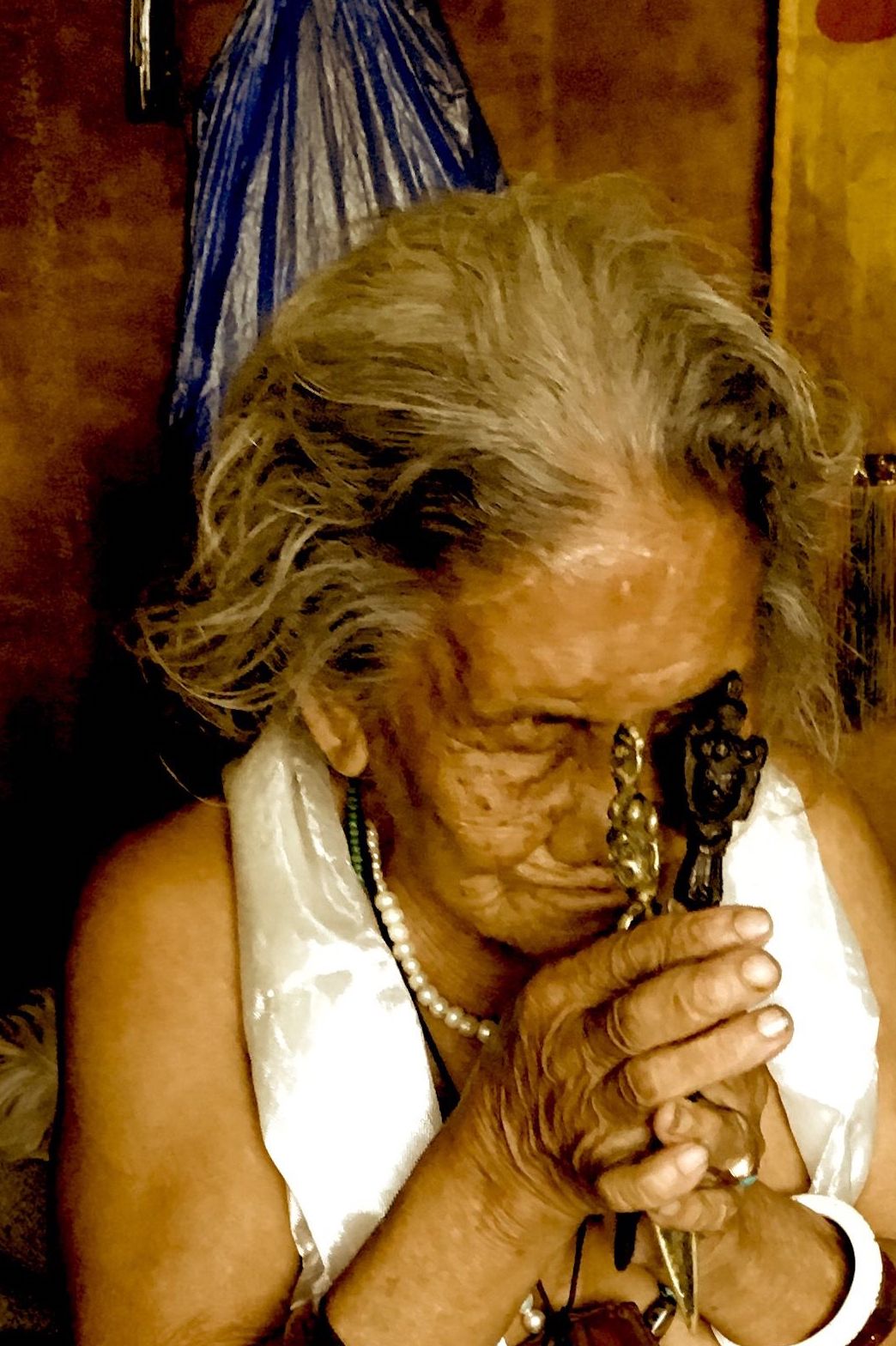
Pema Khandro received one of her most life changing transmissions from a ninety-four year-old female teacher widely recognized as a living Dakini, called Momo-la. This was in Nepal, during the last year of Momo-la’s life. During this conversation, Momo-la told Pema Khandro that she would pass away before she returned and by the time Pema Khandro returned a year later, Momo-la had indeed passed away. But not before Momo-la gave her pointing out instructions and chod transmission.
Other than Momo-la, the rest of Tulku Khandro’s primary teachers have been male. However, she is also grateful to have attended a few teachings and empowerments from female teachers who, she credits them for having paved the way for women in Buddhism. These are: Jomo Samphel Dechen, Lama Rigdzin Drolma (Anne Klein), Khandro Dechen, and Jetsunma Tenzin Palmo.
Pema Khandro has been an advocate for Buddhist women, giving yearly lectures on the women in Buddhism and contributing groundbreaking scholarly research on the history of women in Dzogchen. Her research has contributed new insights into the missing history of Buddhist women outside the monastery. She has presented this research at dozens of academic conferences and has completed a book on the topic which is forthcoming. In 2018, she requested the first all-women’s issue of Buddhadharma magazine to be created. It was produced by Tynette Deveaux and published in 2019. Since 2015, she has also been a presenter at the Sakyadhita International Conference for Buddhist Women in Indonesia, Hong Kong, in the U.S. and online. She was featured in Natural Dharma Fellowship’s Dharma Dialogues on Buddhist Women, and in Dharmadatta’s series on Buddhist women’s responses to abuse. She also created and hosted three podcasts focused on Buddhist women discussing illness and Buddhist practice for LionsRoar that can be listened to here: https://pemakhandro.org/interviews/
4. Pema Khandro’s Teaching Activities
Pema Khandro founded her first Buddhist center in 1999 when she was still a young girl. In 1999, she also founded the organization that became Ngakpa International and later the Buddhist Studies Institute. This started with opening a public center, clinic and several residential training facilities. These started in Southern California. The headquarters later moved to Santa Cruz and then later to Berkeley, in Northern California, and then expanded to Dakini Mountain, in the Tahoe National Forest in Northern California. Tulku Khandro has been an invited teacher for the Dalai Lama Global Vision Summit, Zen Mountain Monastery, Natural Dharma Fellowship, the Dharmadatta Foundation, and many other centers in North America.
Her dedication to the Tibetan Tradition of Buddhist Yogis with its long lineage of non-celibate practitioners stems from her respect for work, committed relationship and family as a fruitful basis for spiritual development.
Since 1999, she has also run a natural health clinic, the Yogic Medicine Institute, and has taught courses on integrating natural health, nutrition, and herbal knowledge into the work of health professionals from every field. The practice of nutrition and herbal knowledge is one of many practical aspects of the knowledge of Tibet’s Buddhist Yogis.
Pema Khandro’s main residential center was previously in downtown Berkeley a few blocks from the University. A dozen full-time residents lived there and practice together and local instructors lead regular community gatherings, meditation classes and discussion groups focused on Buddhist philosophy. Retreats and events with Pema Khandro and other Buddhist teachers were regularly held there for over a decade. This center was expanded and relocated into what is now known as Dakini Mountain, in the Tahoe National Forest of Northern California, close to Nevada City. Dakini Mountain is a thirty-five acre retreat off the grid in a pristine location. It is currently being developed as a pilgrimage site for Vajrayogini with a Vajrayogini stupa and peace garden planned.
Today, Khandro-Ling is another location of Pema Khandro’s Buddhist teaching, it is a farm house in rural Virginia near Charlottesville, where students of Pema Khandro gather once a year for Vajra Sangha retreats.
Pema Khandro also developed a school for in depth training in Buddhist philosophy and practice. She developed this into The Buddhist Studies Institute, in California, a project of Ngakpa Intl a non-profit organization run with her friends and students who first joined her in 1998 – 2000, many of whom are still with her to this day. The community has continued to grow with the leadership of several of her students who serve their local communities as senior practitioners and instructors of classes in meditation and introductory courses on Buddhist teachings. She has trained over a hundred meditation instructors through her yearly online course co-taught with two of her long time students.
Pema Khandro makes available whole scope of the Buddhist teachings through The Buddhist Studies Institute, a project that features scholars from East and West and offers online programming in Vajrayana education from the scholar’s perspective.There she also teaches ongoing long-term Buddhist education for serious students all over the world through retreats, courses and online trainings. Her students regularly post and share these events at PemaKhandro.org, at The Buddhist Studies Institute and through social media.
During her travels, Pema Khandro became familiar with the pressing need for caring for orphans and children’s education in Himalayas. Since relief efforts often overlook smaller but vital aspects of an endangered culture, she has pursued philanthropic work for girls, and elders who live in the borderlands, and children of the ngakpa families in Tibet. Through this work she promotes a practice of Buddhism that is also committed to service, to give back by sustaining Tibetan traditions, ensuring that they flourish in their homeland. For more than a decade a yearly project of Pema Khandro’s community fundraised to support the food, lodging, and education for children and elders in the Himalayas.
Today, Pema Khandro continues to be an advocate of the relevance of Buddhist traditions as Buddhism takes shape in North America. She runs a residential center, leads a thriving community, runs a clinic and non-profit organization. She teaches courses regularly, pursues research projects and continues to cultivate a close relationship with her students and friends who work together in Ngakpa International.
5. Dr. Pema Khandro’s Scholarly Interests
Dr. Pema Khandro received her bachelor’s degree from the University of San Diego (Sociology with a minor in Women’s Studies and Communication). She completed her Master’s degree in Religious Studies focused on Tibetan Buddhism at the University of Virginia. She also completed her PhD in Buddhist Studies at the University of Virginia, and she studies Tibetan and Chinese languages. Her research specializes in the history of Dzogchen and women in Buddhism. Her dissertation focused on the Dakini’s Heart Essence, one of the most important texts of the Dzogchen tradition in the classical period, the fourteenth century. Today Pema Khandro is an Assistant Professor of Buddhist Studies and divides her time between her academic teaching, research, service as a Buddhist Lama, and travel to Asia. Her research has been funded by prestigious groups including the Ford Foundation, Fulbright Hays Fellowship, the Buckner Clay Award in the Humanities, and the Project on Lived Theologies, among many others. She has presented her research at dozens of conferences including the American Academy of Religions, and the International Seminar of Young Tibetologists. Her writing is frequently featured in Buddhadharma magazine and LionsRoar magazine.
_______
Have questions not covered here? This page has many answers to commonly asked questions.

